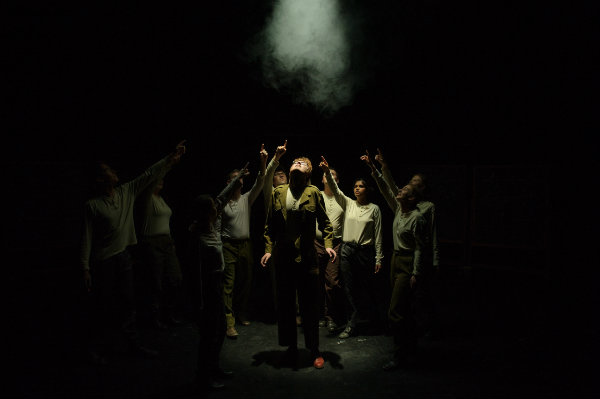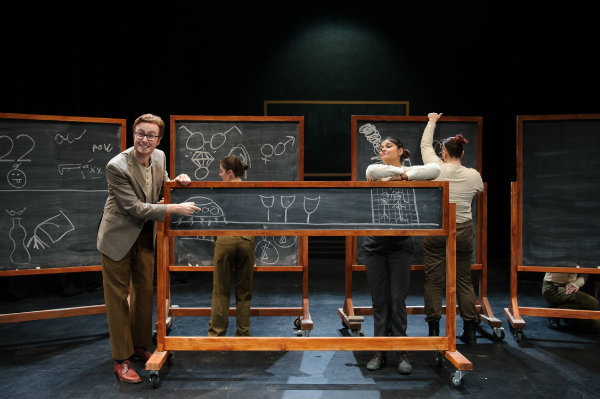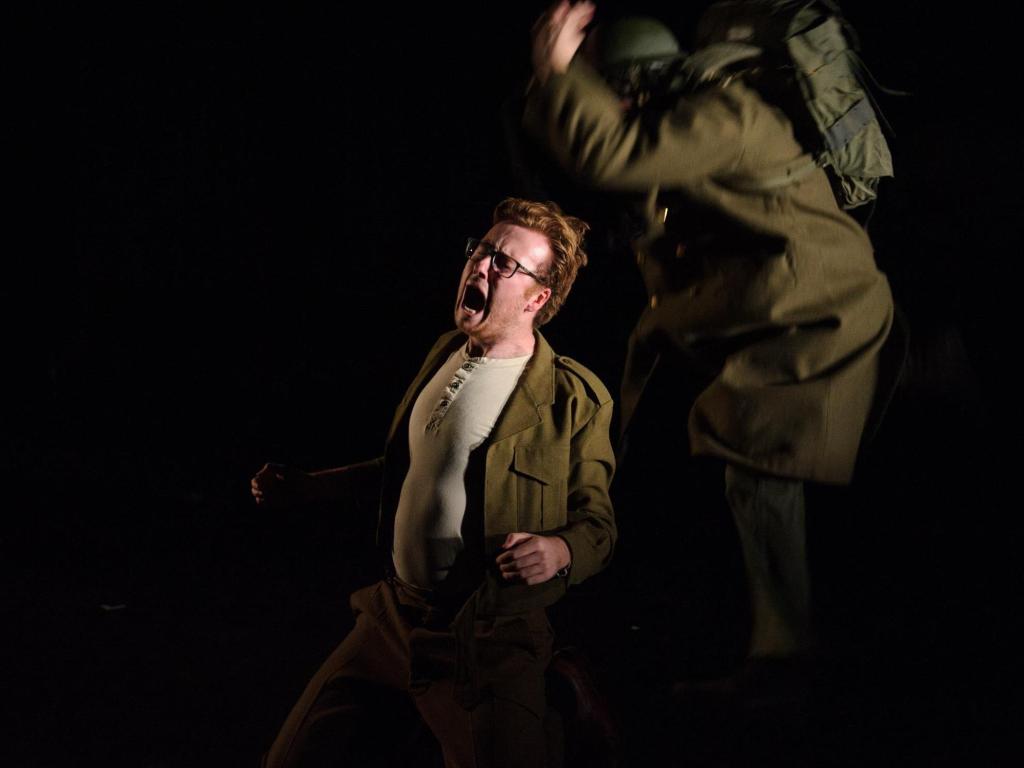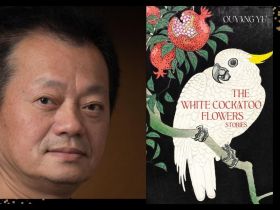Sam Barson in Slaughterhouse Five, a Theatre Works and MUST production. Photo credit: Sarah Walker.
It is difficult to adapt something you love as much as I loved Kurt Vonnegut’s Slaughterhouse Five. This year, on New Year’s Day, I picked up the novel and read it again for the first time in a while. Every page I turned, every sarcastic, scornful indictment of war I read, every time Billy slipped another ratchet tooth through time, I was glad that I had already adapted the darn thing.
I talked to myself a lot: ‘I wonder what Fleur of the Past did there?’ or ‘She better be good, this adaptor lady’. I cannot tell you the relief I felt when, a day later, I finished the book and picked up the adaptation. I still liked it.
So this is how Fleur of the Past did it, to the best of my memory.
Step 1: Read it
I was in my sister’s house in England and it was cold. I read it a lot. I also read That’s Not My Tiger and The Gruffalo many times because I’m a good aunty.
Step 2: Procrastinate
I walked down the street to buy coloured post-it notes. On my way I walked past a statue, beheaded by Cromwell’s men in the 1600. It now stands guard outside a Pizza Express. I marvelled at how visible history is in Europe. Some of it.
I thought of the massacres that lie unmarked in Australia. Some dead are remembered very differently to others. When Vonnegut started writing his book, the bombing of Dresden was barely talked about because the people who lived in that city were Bad People. We like categorising people here on Earth. There are the ones we remember and the ones whose graves are turned into carparks or Woolworths or the Queen Vic Markets. So it goes.
I took the post-it notes home. I read the book again and this time I put different coloured post-its in different places. A colour for the aliens, a colour for the war, a colour for Vonnegut’s own voice, a colour for after the war, a colour ‘for holy shit this bit means a lot to me’. I made the book look very pretty.
Step 3: Panic
I panicked about chapter one. I thought it was the most perfect single chapter I’d ever read. I asked my dramaturg, an undergraduate student who seemed surprising confident telling me what to do, if I could just read the first chapter on stage each night. He said no. I realised that the reason this chapter meant so much to me was it was about a writer being tasked with an impossible task: to craft the meaningless horrors of our world into meaning.
Step 4: Draw pictures
I drew pictures of scenes and played with the order. While the book was difficult to adapt, I celebrated what a gift it was that its form gave me permission to order it however I liked: to slip in and out of time like my protagonist. The pictures were drawn in my niece’s coloured pencils. Her great-grandmother had cowered in a cellar as Dresden burned around her and emerged from the rubble to a city that looked like the surface of the moon. Then she had moved to Scotland and had a baby who had a baby who grew up and married my sister who had a baby who owned coloured pencils. I moved the little pictures around on the crumb-covered carpet. I thought of Vonnegut drawing the story arc on wallpaper in his daughter’s crayons.
Step 5: Remember why the text speaks to you
I couldn’t shake the idea that I needed Vonnegut’s own voice in this play. The author’s voice was what had drawn me to the play so I needed to honour it. I wrote him a monologue – a letter, a warning, an apology – to start the show. Once I had done that, things moved a lot easier. It was the laxative of monologues. It freed things up. Shit was easier after that.

Sam Barson and the cast of Slaughterhouse Five. Photo credit: Sarah Walker.
Step 6: Look for gifts left for you
I found the second gift Vonnegut had left me: he writes dialogue well. He writes it like someone who reads his work out loud. Like a playwright. I thanked him for the gift and happily lifted chunks of dialogue straight from the page.
Step 7: Look for problems left for you
In most adaptions you find the thing that niggles at you. The thing you don’t like about your source material. You argue with it. That helps you clarify your perspective.
The thing I didn’t much like about the book was the women: the way they swirled about in varying states of undress, never controlling the action. But then I saw the men were also little more than props. This is a book written by a man about male trauma and men’s inability to speak. It made me think of my grandmothers, growing up in the shadow of the war their fathers had fought and the silence and the booze they used to forget it.
The central character of this book is the most passive protagonist there has ever been. You see the world move around him. The war makes props of Billy and the other men, just as it makes props of the women. They are propelled through the world, not by their own drive or self-assurance or conviction but by social expectations that they will get on with things.
My initial niggling discomfort with the women of the book helped me understand: the characters that drive the play are all off stage. They are in war rooms and parliaments. Sometimes they are behind big desks or in bathtubs. Sometimes they call each other on the telephone late at night with breath that smells of mustard gas and roses while Billy lies politely in the snow and waits to die.
Step 8: Disagree with your boyfriend
My boyfriend at the time hated the apology I began the play with: ‘I’ve finished my war story now. The next one I write is going to be fun. This one is a failure. It is short and jumbled and jangled because there’s nothing intelligent to say about a massacre. Everyone is supposed to be dead. Everything is supposed to be quiet.’
He told me nothing should start by devaluing itself like this. He told me that by apologising before the play started, I would make the audience fold their arms and place themselves in a position of judgement. I thought that was the most Man thing he’d ever said to me. I am a walking apology. It is part of my identity as a woman. It is how my tribe identifies each other on the street.
I realised that was what drew me to Vonnegut: not just that he is a writer, but that he tells us how grossly inadequate his voice is to tell this story and does it anyway. I embrace inadequacy. I wrote Kurt another scene full of self-deprecation and apology and placed it in the middle of the play, just in case people had forgotten what a terribly doomed endeavour this was. I glared at my boyfriend while he read it.

Sam Barson, Talia Zipper, Simran Giria and Caitlin Duff in Slaughterhouse Five. Photo credit: Sarah Walker.
Step 9: Cast the show
Somewhere in here I went back to Australia and cast the show. I wanted to find actors who looked young and stupid, who were wandering aimlessly through life. But most university students are irritatingly beautiful and have their shit together. I was a bit disappointed but got over it.
I did gender blind casting: no one needs a play where all trauma is shown by the men and all the nursing by the women.
I found my Billy Pilgrim: a hugely intelligent 19-year-old with his shit together, but somehow he was wonderful at being a gormless idiot. His passivity was beautiful to watch. That had been my worry: that placing a motiveless character centre stage would create a black hole that all the aliens in the universe could not distract from. But my Billy was so watchable in his gentle silence. His name is Sam. He is coming back for this season. I’m very glad.
Step 10: Find an ending
I wrote the ending a couple of weeks into rehearsal. My cast and crew gathered around on a little patch of grass in the sunshine. We shared pieces of art that harmonised with the end of the book. Paintings, sculpture, music. I read them the end of the war as told by Kate Seredy in The Singing Tree. It was so anticlimactic. Peace was declared but everyone was too dead, too wounded, too sick, too grief-stricken or too exhausted to celebrate. Beautiful brave words were said by leaders, hands were shook, monuments were built and the people could only whisper, ‘Please, just peace’.
In the rehearsal room, we went looking for that awful stillness. The play ends when the war does but we cannot celebrate: there are bodies to bury. So it goes. So it goes. So it goes. So it goes. So it goes. So it goes.
Theatre Works and Monash Uni Student Theatre’s production of Slaughterhouse Five, adapted and directed by Fleur Kilpatrick, runs from 24 April – 5 May at Theatre Works, St Kilda. Visit www.theatreworks.org.au for details.





